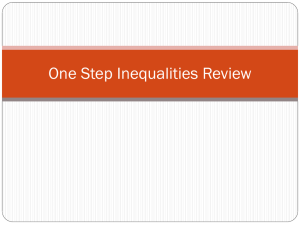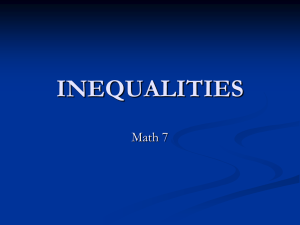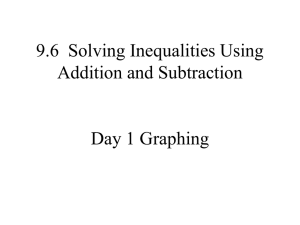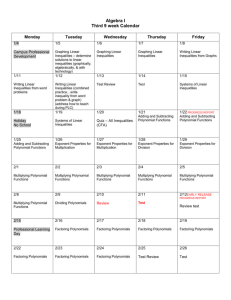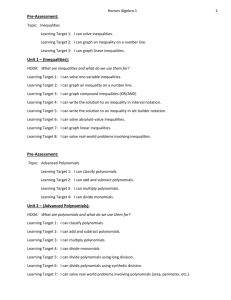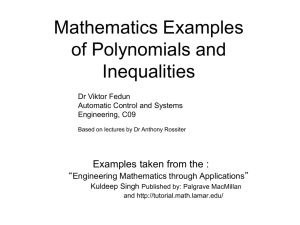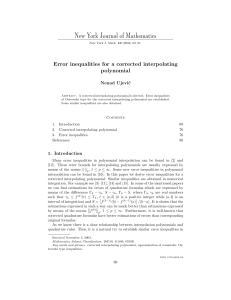MATHEMATICS
advertisement
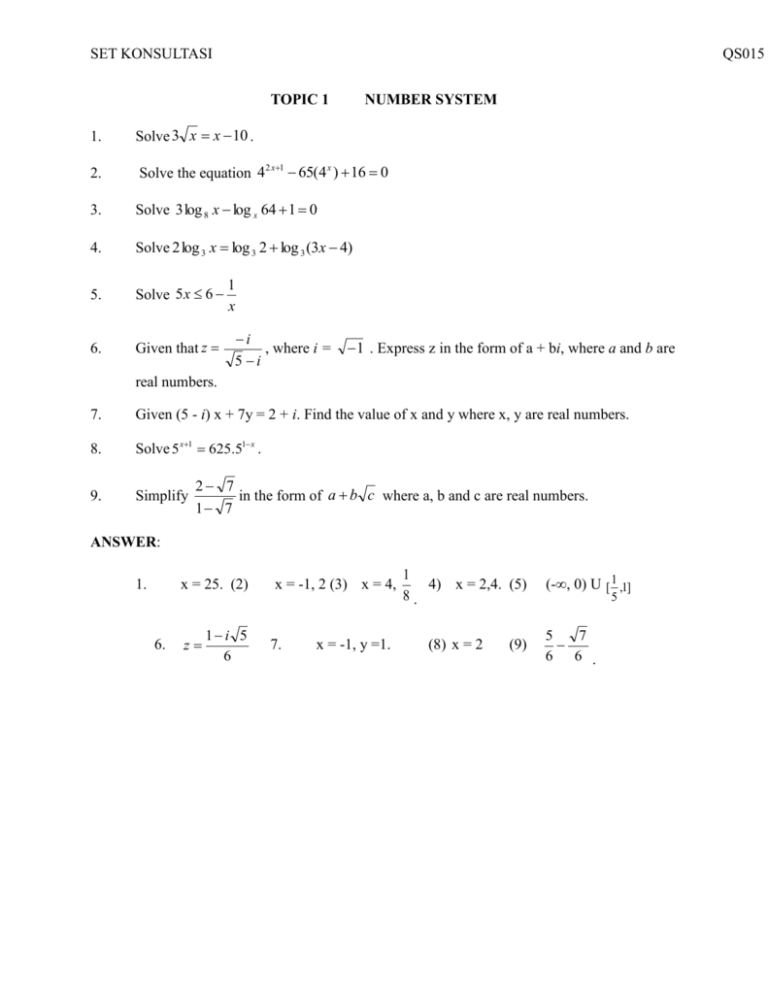
SET KONSULTASI
QS015
TOPIC 1
NUMBER SYSTEM
1.
Solve 3 x x 10 .
2.
Solve the equation 42 x1 65(4 x ) 16 0
3.
Solve 3 log 8 x log x 64 1 0
4.
Solve 2 log 3 x log 3 2 log 3 (3x 4)
5.
Solve 5 x 6
6.
Given that z
1
x
i
, where i =
5 i
1 . Express z in the form of a + bi, where a and b are
real numbers.
7.
Given (5 - i) x + 7y = 2 + i. Find the value of x and y where x, y are real numbers.
8.
Solve 5 x1 625.51 x .
9.
Simplify
2 7
in the form of a b c where a, b and c are real numbers.
1 7
ANSWER:
1.
x = 25. (2)
6.
z
1 i 5
6
x = -1, 2 (3) x = 4,
7.
x = -1, y =1.
1
4) x = 2,4. (5)
8.
(8) x = 2
(9)
(-∞, 0) U [ 1 ,1]
5
5
7
6 6 .
SET KONSULTASI
TOPIC 2
QS015
EQUATION, INEQUALITIES AND ABSOLUTE VALUES
3x 1
1
x3
1.
Solve the inequalities
2.
Solve the inequalities |x+7| > 2|x-5|
3.
Solve the inequalities 5 10 x 10 6 x 2
4.
Find the solution set of the inequalities
5.
Solve the inequalities
6.
Determine the interval of x satisfying the inequalities |x + 5| 7 x 2
7.
Determine the solution set for the inequalities 5 x
8.
Solve
9.
Determine the solution set of the inequalities
1
1
5 3x x 7
x
1
x 8 1 2x
6
1
x
5 x 2 36 x 7
0
2 x 2 20 x 18
1
1
3x 1 x 2
ANSWER:
1
) U (2, ∞) 2. (1, 17) 3.
2
1.
(-∞,-
6.
(-∞,-2) U (1, ∞)
7. (-∞, 0) U [1,
(1,
3
) 4.
2
6
] 8.
5
(-7,-
1
5
1
) U ( , ∞) 5. (-8, )
2
3
2
(-∞, 7) U (9, ∞)
1
3
9. (-2, ) U ( , ∞)
2
3
SET KONSULTASI
QS015
TOPIC 3
SEQUENCE AND SERIES
1.
The first term of an arithmetic sequence is 5. Given the nth term is 81 and the sum of the
first nth terms equal to 860. Find n.
2.
The sum of the first 20 terms of an arithmetic sequence is 580, and the sum of the next 20
terms is 1960. Find the first term and common difference of the sequence.
3.
The sum of the first nth terms of an arithmetic progression is S n 2n 2 7 n . Find the first
term and the common difference. Hence, find the 8th term of the progression.
4a.
4b.
5.
A Geometric sequence has seven terms. The first and fourth terms are 8 and 216
respectively. Find the common ratio and the last term of the sequence.
1
Show that the (r + 1)th term of Binomial expansion ( x 2 ) 20 can be written as
x
20
Tr 1 ( x) 403r .
r
Hence, find the first term.
Expand
1
up to the term x 3 and determine the interval of x for which the
(4 x) 3
expansion is valid. Hence, approximate
1
correct to four decimal places.
(3.9) 3
ANSWER:
1.
n = 20 (2. a) =10, d =2 (3a) = 9, 23. (4a.) r = 3. 5832. (5) - 4 < x < 4. 0.0169.
SET KONSULTASI
QS015
TOPIC 4
1.
MATRICES
1
1 2
Matrix A is given by A 2 1
1
3 1 2 . Find
A1
a)
|A|
(b)
[Ans: |A| = 8
Ad joint of A
(c)
1
1 3
7 5 1
Ad joint of A= 5 7 3
2.
1 1 1 x 1
Given a matrix equation AX = B as 2 1 2 y 2
3 1 4 z 3
a)
Find the determinant of matrix A.
b)
1
1 3
A 1 7 5 1
5 7 3
[Answer: |A| = 3]
6 2 u
2 , find u and v. Determine the ad joint matrix
Given the cofactor matrix of 3 1
v
0 3
of A and hence find the inverse of A.
[Answer: u = 5, v = 3]
2
2
A1
3
5
3
1
1
3
2
3
1
0
1
SET KONSULTASI
3.
QS015
6 2 u
2 . If |A| = -10 and find the values of
Given a matrix A = 3 1
v
0 3
a)
x
(b)
(adjoint)
T
(c)
x 1
if A y 2
z 3
x
Find y .
z
15 5 5
[Answer: x = - 5, (adjoint) = 69 9 21 , x =18.9, y = 2.9, z = 7.1]
12 2 8
T
4.
1 2 1
Given a matrix A = 1 1 1 . Find the value of m and n so that A2 mA nI 0
2 1 3
where I is an identity matrix of 3 x 3. By using the value of m and n
a)
Deduce A1
(b)
Show that A3 3 A2 3 A 0
1
[Answer: m = -3, n = -3, A1 ( A 3I ) ]
3
SET KONSULTASI
QS015
TOPIC 5
1.
Functions and Graphs
1
, x 1. Find g 1 and state its domain and range.
x 1
A function y is defined by g(x) =
1
1,
2
[Answer: Dg (1, ), g 1 (x) = x
Dg 1 : x R \ {0} Rg , Dg Rg 1 (1, )
2.
Given f(x) = ln (3x+2) and g(x) =
ex 2
.
3
a.
Show that f(x) is a one-to-one function algebraically.
b.
Find gf(x) and fg(x). Hence, state the conclusion about the results.
c.
Sketch the graphs of f(x) and g(x) on the same axes. Hence, state the domain and
range of g(x).
3x 4
ex 2
x
[Answer: gf(x)=
,fg(x) = ln( e 4) ,
.Domain f = Range g = (-2,∞).
3
3
Range f = Domain g = R
3.
The function f and g are defined as f ( x)
a.
Find f 1 ( x) and g 1 ( x) .
b.
Evaluate g 1 f (2) .
c.
If g 1 f (r ) 20 , find the value of r.
[Answer: f 1 ( x)
4.
5 2x
, x 3 and g(x) = x – 7.
x3
5 3x
x2
g 1 ( x) x 7 . g 1 f (2) 2 r =4
Given f(x) = e 2 x and g ( x) ( x 1) 2
a.
Find the domain and range of f and g.
b.
Show that gf(x) = (e -2x 1) 2
[Answer: D f R . R f : (0, ) . D g R. Rg : (0, )
SET KONSULTASI
5.
QS015
e 2 x , x 0
Given P( x)
. Find P 1 ( x)
x 2, x 0
1
ln x, x 0
[Answer: P ( x) 2
x 2, x 2
1
6.
The function f and g are defined as, f(x) = x 3 , x 3 and g ( x) x 2 1, x 1 . Find the
inverse function, f 1 ( x) and determine its range. Then, evaluate fg(-3).
[Answer: f 1 ( x) x 2 3 R f 1 : [3, )
7.
fg (3) 13
A function f is defined by f ( x) x 2 5 x 6 for 0 x 6 . State the range of f and
determine whether f is one to one.
1
[Answer: D f : [0,6] R f : [ , )
4
8.
Given g(x) = e 2 x , f(x) = 3-x, x R . Find g 1 and hence obtain gf 1 ( x) .
1
[Answer: g 1 ( x) ln x
2
gf 1 ( x) x
SET KONSULTASI
QS015
TOPIC 6
1.
Express
Polynomials
5x 3
as partial fraction.
( 2 x 7) 2
[Answer:
2.
5x 3
5
23
=
2
2(2 x 7) 2(2 x 7) 2
( 2 x 7)
If (x - 9) is one of a function of polynomial P( x) x 3 rx s .
a.
Find the values of r and s.
b.
Hence, factorize P(x) completely. Find the roots of the equation P(x) = 0.
[Answer: r = -5, s = -36. (b) P(x) = ( x 9)( x 2 4)
3.
Given a polynomial P( x) x 3 ax b has factors (x+1) and (x+5).
a.
Find the value of the constants a and b.
b.
Factorize P(x) completely.
c.
Obtain the solution set for P(x) < 0
[Answer: a = -31, b = -30 P(x) = (x-6)(x+5) (,5)U (1,6)
4.
Dividing P( x) x 2 rx s by (x+2) and (x-2) give a remainder of 5 and -11 respectively.
Determine the values of a and b.
[Answer: r = -4, s = - 7]
5.
Express
5x 6
in the form of partial fraction.
( x 1)( x 2 2)
[Answer:
6.
7
9 x 16
5( x 1) 5( x 2 2)
The polynomial P( x) x 3 2 x 2 ax b , where a and b are constants, has a factor of
(x+3) and leaves a remainder of 8 when it is divided by (x-1).
a.
Find values of a and b.
b.
Factorize P(x) completely by using the values of a and b obtained from part (a).
Hence, find the real roots of P(x) = 0, where and b are not equal to zero.
SET KONSULTASI
QS015
[Answer: a = -9, b = 18. P(x) = (x-3)(x-2)(x+3). x = - 3, 3, 2
7.
Two factors of polynomial P( x) x 3 ax 2 bx 8 are (x-1) and (x+2). Determine the
values of a and b and find the third factor of the polynomials. Hence, express
x 2 5x 6
P( x)
as a sum of partial fraction.
[Answer: a = 5, b =2. Third factor (x+4).
x 2 5x 6
10
2
21
]
P( x)
3( x 2) 15( x 1) 5( x 4)


